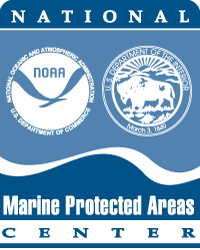
Human uses of the ocean are growing, requiring new and forward-looking approaches to comprehensive ocean planning. To meet this challenge, NOAA's National Marine Protected Areas Center is developing a portfolio of place-based ocean planning tools to help coastal communities better understand the drivers, patterns, conflicts and benefits of ocean uses along their shores. These include:
A Common Language of Ocean Uses (pdf): Flexible definitions of a wide range of typical ocean uses to help planners, managers and stakeholders map and understand the drivers, impacts and benefits of ocean uses across multiple scales.
Participatory Ocean Use Mapping Process
The MPA Center has developed and applied a participatory mapping process to gather ocean use data by engaging local and regional ocean experts through interactive mapping. This flexible and mobile approach can be refined and adapted for any region or domain and to address multi-scaled management decisions.
In collaboration with NOAA's Office for Coastal Management, this method has been published as a Guidebook to Participatory Mapping of Ocean Uses (pdf) with associated Appendices (pdf). You can also visit How to Map Ocean Uses with Participatory GIS for an abbreviated version of the guidebook.
Ocean Uses Data
Through various partnerships, the MPA Center has led a series of participatory mapping projects throughout the U.S. to collect spatial data on ocean uses in support of a wide range of marine planning needs.
The Pacific Regional Ocean Uses Atlas (2015) (pdf)
This project was designed to document a full range of human activities and sectors in the ocean to support offshore renewable energy planning in the Bureau of Ocean Energy Management's Pacific region. Downloadable GIS data (Oregon/Washington and Hawaii), web mapping services (Oregon/Washington and Hawaii) and project report (with maps) are available.
Virginia's Atlantic Coast Recreational Use Mapping Project (2012) (pdf)
This project supported Virginia coastal zone management planning efforts to fill regional data gaps for the Mid Atlantic Regional Council on the Ocean (MARCO). Data are available through Virginia's Coastal Geospatial and Educational Mapping System (GEMS).
St. Thomas East End Reserve Coastal Use Mapping Project (2012)
This project was intended to inform marine protected area planning and plan review in the U.S. Virgin Islands' St. Thomas East End Reserve. Data, maps and related products are available for download.
West Maui Coastal Use Mapping Project (2011)
This project informed coral reef conservation and planning strategies for West Maui. Data are available for download or as web mapping service.
Hawaii Coastal Use Mapping Project (2010) (pdf)
This project supported the development of coral reef conservation and planning strategies for the northwest coast of the Island of Hawaii. Data are available for download, through an interactive viewer or as web mapping services.
New Hampshire and Southern Maine Ocean Uses Atlas (2010) (pdf)
The impetus for this atlas was to inform a Spill of National Significance Drill in Portland, Maine.
Data are available for download and as web mapping services.
California Ocean Uses Atlas (2008-2009) (pdf)
This project was designed to support the California Marine Life Protection Act Initiative's marine protected area designation process. Data are available for download and as web mapping services.
Recreational Uses
Recreation is one of the main purposes of MPAs, but needs to be managed to ensure that habitats and resources are not harmed by recreational activities. The MPA Federal Advisory Committee and the National Marine Sanctuary Advisory Councils approved a call to action entitled Destination Marine Protected Areas: Sustaining America's Most Treasured Ocean Places for Recreation and Stewardship (pdf), outlining four key actions protected area agencies and partners can take to promote and manage sustainable recreation.
 Marine Protected Areas
Marine Protected Areas